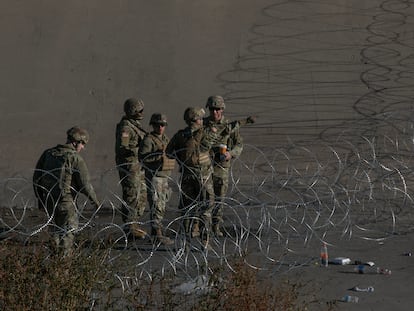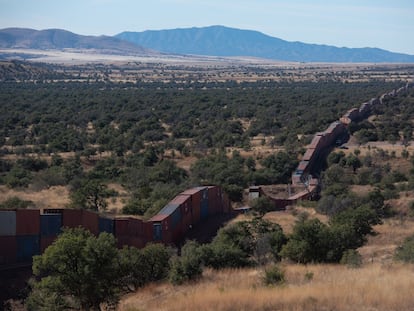Texas governor sends 100 migrants to DC residence of US Vice President Kamala Harris
Greg Abbott and other Republican leaders are seeking to increase pressure on the federal government over immigration policy in the grip of a cold snap and with the fate of Title 42 pending in the Supreme Court


Over 100 migrants who arrived in the United States via Mexico’s border with Texas have been bused to Washington DC and dropped off directly outside Vice President Kamala Harris’ official residence. Republican Texas Governor Greg Abbott commissioned a fleet of buses to transport between 110 and 130 people, the majority of them families with children, to the capital in protest at the immigration policy of President Joe Biden’s administration. It is not the first time that Harris’ Washington residence has served as the final destination for a group of migrants: at the beginning of October, Abbott sent a similar number of foreign nationals, the majority of them Venezuelans, to the vice president’s door. Since last spring, the Texas governor has moved thousands of migrants on from his state, sending them mostly to Washington DC, Chicago and New York.
On this occasion, the circumstances were different. In the grip of a huge winter storm that battered the US from the Great Lakes to the Rio Grande over the weekend, migrants also face further uncertainty at the border while the fate of Title 42 is decided in the Supreme Court. The Donald Trump-era legislation was enacted during the coronavirus pandemic and gives US authorities the power to expel or prevent the entry of people who have recently been in a country where a communicable disease was present – in effect, it provides carte blanche for almost automatic deportation. Title 42 was due to expire on December 21 after a federal judge ordered the Biden administration to lift the measure in November, a ruling that was subsequently appealed. The Centers for Disease Control and Prevention (CDC) said last May that Title 42 was no longer required for pandemic containment, leading to a lawsuit by Republican southern states including Arizona, Louisiana, and Missouri.
Temperatures plummeted to -10º degrees Celsius (14ºF) over the past few nights in El Paso, turning crossing points into an open-air freezer for asylum seekers. When these reached the border, they were informed of the plan to send them to Washington by volunteers, despite improvised shelters having been set up in the area to receive them. NGOs providing assistance at the border coordinated with Washington over the arrival of the migrants, some of whom were wearing only t-shirts. They were later transferred to a church in the Capitol Hill neighborhood, according to sources from the NGO SAMU First Response as quoted by Reuters.

Abbott, who has been fiercely criticized by the White House, and other Republican governors have employed this method – a political fait accompli – to send thousands of migrants to Democrat-led cities that describe themselves as refuges for immigrants. Through this charter system, the Republicans also intend to drive the national debate over immigration to the United States. Last week, nine buses were sent from the US border to Washington, containing mostly Ecuadorian and Colombian migrants, according to SAMU First Response.
These Democratic cities, chief among them DC, Chicago and New York, face another issue that is increasing in scale and being exacerbated by the extreme cold: despite defining themselves as safe havens for migrants, simultaneously they are struggling to provide help to the thousands of homeless people - many of them with mental health issues - living on their streets. A lack of shelters has been laid bare in New York precisely because of the arrival of more than 21,000 migrants since April. The city’s mayor, Democrat Eric Adams, has asked for material help from the federal government to respond to the emergency, which may become untenable if the Supreme Court puts a definitive end to Title 42.
At the beginning of October, Adams declared a state of emergency due to the massive influx of migrants. In November, he expanded the network of resources for new arrivals by setting up eight information centers for asylum seekers to file their applications - a system that is now saturated – and to provide their initial safe-conducts to get around the city, such as the New York City Card. In a move described as erratic by his critics, Adams opened a controversial camp on Randall’s Island, to the north of Manhattan, with capacity of 1,000 beds, theoretically to provide temporary accommodation for men traveling alone, only to close it again weeks later. The few arrivals who had been housed there were transferred to a repurposed hotel in downtown Manhattan. The same system was used during the pandemic to provide shelter for homeless people but proved to be insufficient and dysfunctional, according to human rights NGOs.
Faced with this double housing crisis, the New York City Council has asked churches, temples and synagogues for help in accommodating asylum seekers to “guarantee a space with bathroom and kitchen where a family or single individuals can sleep at night or live temporarily.” However, New York’s efforts to respond to the influx of migrants have not managed to prevent tragedies. Ten days ago, a 26-year-old Venezuelan took his own life in a shelter in Queens. In September, a young mother of two did likewise in the same New York borough.
Sign up for our weekly newsletter to get more English-language news coverage from EL PAÍS USA Edition
Tu suscripción se está usando en otro dispositivo
¿Quieres añadir otro usuario a tu suscripción?
Si continúas leyendo en este dispositivo, no se podrá leer en el otro.
FlechaTu suscripción se está usando en otro dispositivo y solo puedes acceder a EL PAÍS desde un dispositivo a la vez.
Si quieres compartir tu cuenta, cambia tu suscripción a la modalidad Premium, así podrás añadir otro usuario. Cada uno accederá con su propia cuenta de email, lo que os permitirá personalizar vuestra experiencia en EL PAÍS.
¿Tienes una suscripción de empresa? Accede aquí para contratar más cuentas.
En el caso de no saber quién está usando tu cuenta, te recomendamos cambiar tu contraseña aquí.
Si decides continuar compartiendo tu cuenta, este mensaje se mostrará en tu dispositivo y en el de la otra persona que está usando tu cuenta de forma indefinida, afectando a tu experiencia de lectura. Puedes consultar aquí los términos y condiciones de la suscripción digital.
More information

Texas militarizes the Rio Grande between El Paso and Ciudad Juárez
Archived In
Últimas noticias
Maduro pleads not guilty before the federal court in New York: ‘I am still the president of Venezuela’
A new test can detect Alzheimer’s from a finger prick
UN team enters Sudanese city of El Fasher after paramilitary massacre: ‘It’s like a ghost town’
A recipe for resistance: Indigenous peoples politicize their struggles from the kitchen
Most viewed
- Gilles Lipovetsky: ‘If you want to live better and fall in love, take Prozac, don’t look to philosophy’
- Alain Aspect, Nobel laureate in physics: ‘Einstein was so smart that he would have had to recognize quantum entanglement’
- Alvin Hellerstein, a 92-year-old judge appointed by Bill Clinton, to preside over Maduro’s trial in New York
- Why oil has been at the center of Venezuela-US conflicts for decades
- Maduro’s downfall puts China’s relationship with Venezuela to the test









































